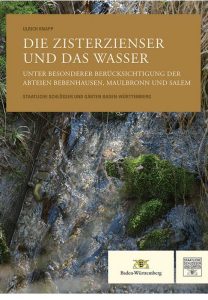Monographs
The Cistercians and the water
with special reference to the abbeys of Bebenhausen, Maulbronn and Salem
Autor: Ulrich Knapp

Water was a key location factor for the establishment of a self-sufficient monastery: Fresh spring water was needed for drinking, while water from flowing streams was essential as an energy source and for cleaning the monastery. Natural waters provided food such as fish, crabs, and mussels. If large enough, they were also used as a means of transport.
The Cistercians optimized the hydraulic infrastructure techniques developed in the great Benedictine monasteries of the 10th and 11th centuries, bringing them to a high level of perfection. In the 12th to 14th centuries, the large convents required correspondingly extensive complexes with latrines, bathhouses, and washhouses for the monks and laymen, as well as appropriate facilities for infirmary. For the optimal functioning of the latrines and the operation of the monastery mills, a secure water supply in sufficient quantities was essential. Most monasteries constructed extensive water reservoirs for this purpose. The diversion of natural waterways also served this purpose.
The Cistercians placed particular importance on fully legally securing access to the water resource. In addition to the use of springs, this applied especially to the use of hydropower and fishing rights. From the late Middle Ages onwards, separate fish ponds were created next to the reservoirs.
Case studies are dedicated to the monasteries of Bebenhausen, Maulbronn and Salem, which are managed by the State Palaces and Gardens of Baden-Württemberg.
Details
Erschienen: 2021
ISBN: 978-3-7319-0350-5
262 pages, 264 mostly colored illustrations,
soft cover, 21,0 x 29,7 cm
Michael Imhof Verlag GmbH & Co. KG, 36100 Petersberg
29,95 € in bookstores, 25,00 € for Members, 22,00 € for student members and members under 25 years of age (available at the Frontinus Society office, all prices plus shipping costs, Contact)
Monographs
The Cistercians and the water
with special reference to the abbeys of Bebenhausen, Maulbronn and Salem
Author: Ulrich Knapp

Water was a key location factor for the establishment of a self-sufficient monastery: Fresh spring water was needed for drinking, while water from flowing streams was essential as an energy source and for cleaning the monastery. Natural waters provided food such as fish, crabs, and mussels. If large enough, they were also used as a means of transport.
The Cistercians optimized the hydraulic infrastructure techniques developed in the great Benedictine monasteries of the 10th and 11th centuries, bringing them to a high level of perfection. In the 12th to 14th centuries, the large convents required correspondingly extensive complexes with latrines, bathhouses, and washhouses for the monks and laymen, as well as appropriate facilities for infirmary. For the optimal functioning of the latrines and the operation of the monastery mills, a secure water supply in sufficient quantities was essential. Most monasteries constructed extensive water reservoirs for this purpose. The diversion of natural waterways also served this purpose.
The Cistercians placed particular importance on fully legally securing access to the water resource. In addition to the use of springs, this applied especially to the use of hydropower and fishing rights. From the late Middle Ages onwards, separate fish ponds were created next to the reservoirs.
Case studies are dedicated to the monasteries of Bebenhausen, Maulbronn and Salem, which are managed by the State Palaces and Gardens of Baden-Württemberg.
Details
Published: 2021
ISBN: 978-3-7319-0350-5
262 pages, 264 mostly colored illustrations,
soft cover, 21,0 x 29,7 cm
Michael Imhof Verlag GmbH & Co. KG, 36100 Petersberg
29,95 € in bookstores, 25,00 € for Members, 22,00 € for student members and members under 25 years of age (available at the Frontinus Society office, all prices plus shipping costs, Contact)